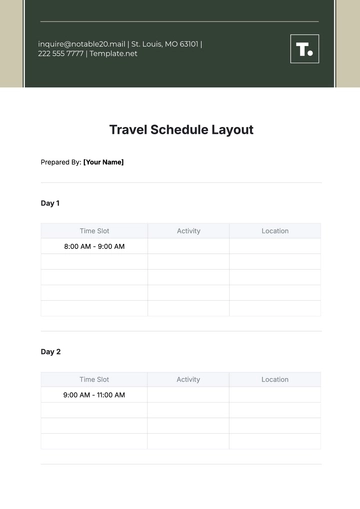Free 2 Week Eastern Europe Itinerary

Hello dear traveler, I'm [Your Name] and I'm delighted to guide you through an incredible 2-week journey in the heart of Eastern Europe. Our company, [Your Company Name], is passionate about crafting unforgettable travel experiences, and we hope this detailed itinerary provides you with a glimpse of the adventure you're about to embark on. If you have any questions, do not hesitate to reach out to me at [Your Company Email]. For more information about us, visit [Your Company Website].
Why Visit Eastern Europe: Eastern Europe offers a captivating blend of history, culture, and natural beauty, providing a unique and often less-explored travel experience. The region boasts UNESCO World Heritage sites like Prague's Old Town and Budapest's Buda Castle, showcasing centuries-old architecture and charming landscapes. Visitors can immerse themselves in diverse cultures, from the vibrant traditions of Poland's Krakow to the imperial splendor of Vienna. With a lower cost of living compared to Western Europe, Eastern Europe offers an affordable yet enriching travel destination. Its rich history, welcoming locals, and tapestry of landscapes make it an ideal destination for those seeking both adventure and cultural exploration. |
Brief History of Eastern Europe: Eastern Europe has a complex and diverse history shaped by various civilizations, empires, and geopolitical shifts. In the medieval period, the region witnessed the emergence of powerful kingdoms such as Poland, Hungary, and Bohemia, each contributing to the rich cultural tapestry. However, it also faced invasions from Mongols and Ottoman Turks. The late medieval and early modern era saw the rise of the Grand Duchy of Lithuania, the Polish-Lithuanian Commonwealth, and the Habsburg Monarchy, which exerted significant influence over the territories. The region experienced turmoil during the 20th century, marked by the World Wars, the Russian Revolution, and the subsequent establishment of communist regimes under Soviet influence, which persisted until the fall of the Iron Curtain in 1989. Post-communist Eastern Europe has undergone substantial political, economic, and social transformations, seeking integration with Western institutions while preserving its unique cultural identities.
The dissolution of the Soviet Union in 1991 further reshaped the geopolitical landscape, leading to the emergence of independent states such as Ukraine, Belarus, and the Baltic nations. Today, Eastern Europe reflects a dynamic blend of historical legacies, varying degrees of economic development, and a continuous quest for political stability and identity in the face of evolving global challenges.
Day 1-3: Prague, Czech Republic |
|
 "Charles Bridge"
"Charles Bridge"
Charles Bridge is an iconic medieval stone bridge that spans the Vltava River in Prague, Czech Republic. Constructed in the 14th century, it connects the Old Town with Prague Castle and offers breathtaking panoramic views of the city. The bridge is adorned with 30 impressive baroque statues, depicting various saints and historical figures, creating a unique and picturesque atmosphere. A popular destination for both tourists and locals, Charles Bridge is known for its historical significance and architectural beauty. Its pedestrian-only status allows for leisurely strolls while enjoying street performances and admiring the stunning Prague skyline.
Day 4-5: Vienna, Austria |
|
 "Schönbrunn Palace"
"Schönbrunn Palace"
The best time to visit Schönbrunn Palace in Vienna is during the spring months of April to June. During this period, the palace gardens are adorned with vibrant blossoms, creating a picturesque and colorful landscape. The mild weather allows for pleasant strolls through the extensive grounds, and the Baroque architecture of the palace is complemented by the beauty of blooming flowers. Additionally, spring offers a more relaxed atmosphere compared to the busier summer tourist season, allowing visitors to appreciate the grandeur of Schönbrunn Palace with greater tranquility.
Day 6-7: Budapest, Hungary |
|
 "Buda Castle"
"Buda Castle"
Day 8-9: Krakow, Poland |
|
 "Wawel Castle"
"Wawel Castle"
Day 10-11: Warsaw, Poland |
|
 "Warsaw, Poland"
"Warsaw, Poland"
Day 12-13: Dubrovnik, Croatia |
|
 "Dubrovnik, Croatia"
"Dubrovnik, Croatia"
Day 14: Departure |
|
Activities for Tourists: Engage in a relaxing bath at Budapest's Széchenyi Thermal Bath, cruise along the Danube River, and savor traditional Hungarian cuisine. Take a guided tour through the haunting history of Auschwitz-Birkenau or explore the vibrant street art scene in Bucharest, Romania. Attend a classical music concert in Vienna, go hiking in the Tatra Mountains, or unwind on the beautiful beaches of the Adriatic Sea in Croatia. Eastern Europe offers unique activities, including exploring underground salt mines in Poland, participating in folk festivals, and experiencing the lively nightlife of Belgrade, Serbia. Whether it's cultural immersion, outdoor adventures, or culinary delights, Eastern Europe provides a diverse range of activities for every type of traveler. |
Travel Restrictions: |
Visa Requirements:
Ensure that you have the necessary visas for each country you plan to visit. Requirements can vary, so check with the embassies or consulates of the countries on your itinerary.
Entry and Exit Requirements:
Verify the entry and exit requirements for each country, including any specific documentation, health certificates, or travel insurance.
Transportation Restrictions:
Be aware of any restrictions or changes to transportation services, including flights, trains, and buses that may affect your itinerary.
Safety and Security:
Stay informed about the safety and security situation in the countries you plan to visit. Check travel advisories from your government and follow any recommendations or warnings.
Local Regulations:
Be aware of local regulations, such as mask mandates, curfews, or specific rules in certain areas. Stay updated on any changes during your trip.
What to See in Eastern Europe: Explore the fairy-tale charm of Cesky Krumlov in the Czech Republic, the historic Wawel Castle in Krakow, and the picturesque Carpathian Mountains in Romania. Dive into the lively atmosphere of Budapest's ruin bars, witness the resilient history at Warsaw's Uprising Museum, and stroll through the enchanting streets of Dubrovnik's Old Town. Discover the architectural wonders of Vilnius in Lithuania and the stunning landscapes of Slovakia's High Tatras. Eastern Europe's diverse attractions cater to various interests, from history enthusiasts to nature lovers. |
- 100% Customizable, free editor
- Access 1 Million+ Templates, photo’s & graphics
- Download or share as a template
- Click and replace photos, graphics, text, backgrounds
- Resize, crop, AI write & more
- Access advanced editor
Explore the wonders of Eastern Europe effortlessly with our 2-Week Itinerary Template, available exclusively on Template.net. This meticulously crafted guide is not only packed with vivid details but also editable and customizable to suit your preferences. Seamlessly personalize your journey using our Ai Editor Tool, ensuring a travel experience tailored just for you.





























